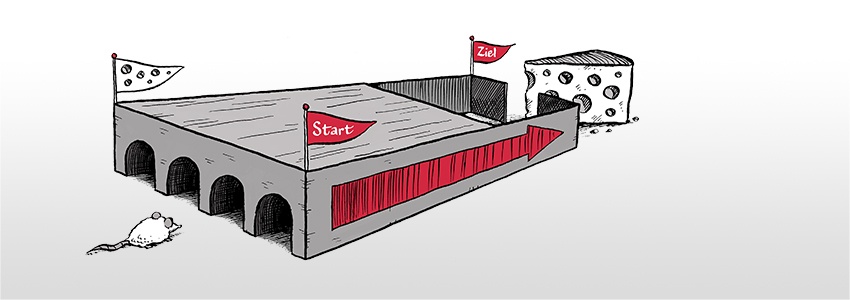Maybe you know the problem: You have researched a new sofa on your smartphone. You bought it later on your laptop. However, your smartphone now displays ads for the sofa you are sitting on. The goal of cross-channel marketing is to prevent such instances of redundant advertising.
Another situation that might be familiar to you: you relax in front of the TV. At the same time, you use your tablet or smartphone to respond to messages or to shop online. This is called second screening, i.e. use two screens at the same time.
Both examples show that potential customers are now on several channels. According to the Adobe Digital Index, Europeans have an average of 6.1 connected devices, 2.9 of those are used daily. Although 78 percent of Europeans still use a computer to shop, 37 percent have made purchases on their smartphone. The fact that the computer is still the preferred device for online shopping does not mean that the Customer Journey exclusively takes place on a single device. In fact, around fifty percent of online shoppers use more than one device until they reach a buying decision. Social media are now most commonly used on smartphones; e-mail and video are increasingly taking place on small screens as well (further statistics on the topic can be found in our infographic).
Marketing in the era of numerous communication channels
The number of communication channels has increased significantly over the past decade. This allows brands to reach potential customers virtually around the clock. This development represents both an opportunity and a challenge: brands must succeed in offering their customers homogeneous customer experiences. It is therefore not enough to feed the same information into different communication channels. This would not be a cross-channel, but a multi-channel strategy. Although both terms are often used synonymously, there is this crucial difference: As the name already reveals, a cross-channel strategy allows customers to move across the various channels of the Customer Journey without experiencing dissonances or redundancies.
Although many companies today have adopted a cross-channel strategy, their customers often have a fragmented customer experience. This means that switching from one communication channel to the next does not work homogeneously.
Cross-channel marketing: avoid fragmentariness
The available communication channels range from radio to print to the numerous online media such as websites, social networks or shops. This diversity allows companies to provide rich customer communications, but also presents them with challenges when they want to be effective and achieve a high ROI.
Challenge 1: channel-specific communication
Brands love Facebook because it allows them to build their image more easily and to interact with customers informally. Customers appreciate this and follow the fan pages by the millions. However, what they do not like on social media is when brands blatantly try to sell them something. Hence: the content always has to match the channel on which it is communicated.
Challenge 2: data evaluation
The more channels are being used, the more data is collected. These data are very useful because they enable the comprehensive analysis of customers' behavior and demands. Marketers can uses these insights for developing highly targeted campaigns. However, the fact that these data come from various sources poses a serious challenge. Ultimately, bringing these data together and making them useful is probably the biggest challenge in cross-channel marketing at the moment.
This also applies to a second important aspect of cross-channel marketing: Individual customers use various devices, IDs for social handles, and e-mail addresses. As a result, there is a risk of having duplicates or losing sight of customers as soon as they change devices.
This fact makes identity mapping a critical component of cross-channel marketing. It is the only way to achieve a consistent, cross-channel customer experience. To return to the aforementioned example of our new sofa owner who still gets sofa advertisements on his smartphone: in this case, the brand or online shop selling sofas has not matched the user's smartphone ID and the computer ID, meaning it does not know it is advertising to a user who already is a customer. This makes an ID assignment strategy a crucial component of cross-channel marketing.
The goal is to be able to identify the user no matter the devices/he uses to interact with one of the brand's touch points in order to display relevant, channel-specific messages.
Challenge 3: consistency
Each user has different needs and each channel requires a different kind of communication. Still, the brand has to be recognizable on every channel. It has to be clear what the brand stands for at all times to achieve a high degree of recognition and identification. No matter how many media a brand uses to communicate, it must always be recognizable.
The desired consistency requires the marketing team to work together seamlessly. The CMO is in charge to break down unnecessary barriers among teams and to make collaboration tools available. If the e-mail marketing team and the social media team hardly ever communicate with each other, mismatched messages are being sent out. This can hollow out the brand and will leave customers puzzled as to what the brand stands for. Hence cross-channel marketing can only be effective if the marketing team works hand in hand perfectly.
The benefits of a cross-channel strategy:
- You get more conversions
- You improve customer loyalty
- You get a 360-degree view of your customers
- You improve internal cooperation
A cross-channel marketing strategy can only be successful if both strategy and technology interlock perfectly. The use of different channels and displaying content tailored to individual customers requires a powerful marketing automation solution as well as a connected data management platform (DMP). Read more about DMPs in our free Whitepaper.
Our service: True to our motto "Marketing Meets Information Technology", we can offer you all services from consulting and creation to technical realization from a single source. Get in touch!










